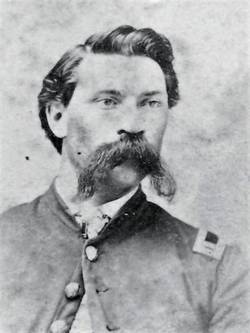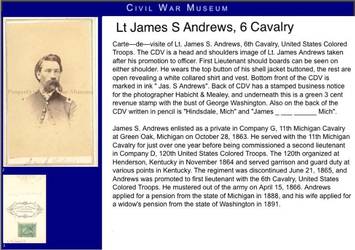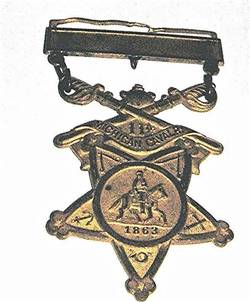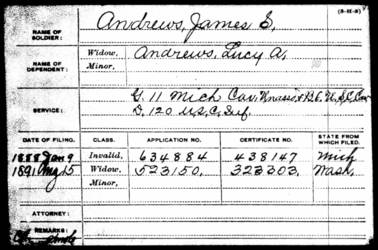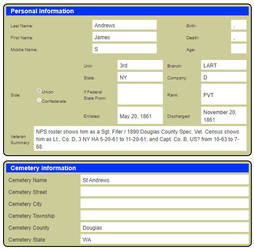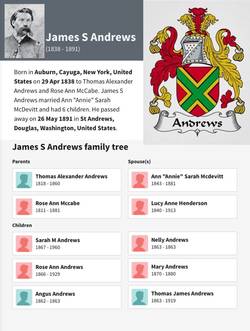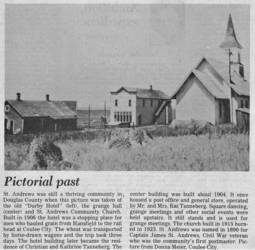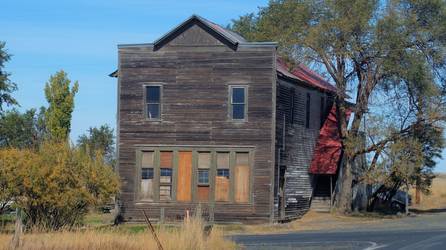James S. Andrews
Representing: Union
Family History
Created by Brian
James S Andrews
- Birth
- 29 Apr 1838
Auburn, Cayuga County, New York, USA
- Death
- 26 May 1891 (aged 53)
Saint Andrews, Douglas County, Washington, USA
- Burial
- Douglas County, Washington, USA
- Memorial ID
- 22404862
- Private, Co D, 3rd New York Light Artillery
20 May 1861 - 20 Nov 1861
NPS roster shows him as a Sgt. Fifer / 1890 Douglas County Spec. Vet. Census shows him as Lt., Co. D, 3 NY HA 5-20-61 to 11-20-61, and Capt. Co. B, US? from 10-63 to 7-68. Add. info from Fred Pflugrath, Peshastin, WA
http://www.suvcwdb.org/
*The town of Saint Andrews was named after him.
--------
In 1890, after living in the area for three years, Captain James Saint Andrews and his wife, Lucy A. Andrews, decided to open a post office in their small farmhouse. Lucy was to be the postmaster for the families in the surrounding area. Captain Andrews was a Civil War veteran, early homesteader in the area, and Douglas County's 2nd prosecuting attorney. His wish was for the new post office to be called "Andrews," but for reasons unbeknownst to the family, the US Post Office preferred "Saint Andrews." Even after James' death the following summer, when Lucy was forced to give up the position, the name stuck.
As the title of postmaster changed hands, so did the location of Saint Andrews. James and Lucy Andrews' ranch was actually two miles south of the community's current location. When Miss Dodd became postmaster in 1902, she moved the post office to the 4-way intersection that would become its permanent home. Before the Saint Andrews school was moved to the intersection, classes were held in Joe Bogart's shack, just southwest of town. The small shack had no floor, and the children had to use wooden boxes and 5-gallon oil cans as seats. During those early days, students from nearby areas also travelled to the Baird, Gilbert, and Highland schoolhouses. The Saint Andrews school moved around for many years but remained near the Saint Andrews intersection until 1972, when it was dismantled to make room for the new Grange Hall.
The Saint Andrews Cemetery began with the burial of none other than Captain Andrews. For many years, a large American flag was raised on his gravesite every Memorial Day and 4th of July. To get to the cemetery, you must travel 1 mile South of Saint Andrews Grange Hall and then 1/2 mile East on 5 Road NE. After 1/2 mile, you turn south for another 1/2 mile. The cemetery lies just over the top of a hill, which has piles of field rocks dumped on it. The cemetery covers roughly 6 acres and has fence on three sides. The early pioneers of the area are buried there.
Danish Cemetery: The smaller Danish Cemetery holds many of the pioneers from the Danish influx into the Saint Andrews area. To get there, travel 1 mile South of Saint Andrews, then turn Westward along 5 Road NE. After ½ mile, the cemetery will be on the north side of the county road and has a fence around it with a gate.
The Darby Hotel was established in 1906, at the height of Saint Andrews' success. The Darby's had bought the two-story building from Mr. Menger, who ran a general store out of the top floor. The bottom floor had served as a meeting hall. For years, the Darby Hotel served as a stopping point for men hauling wheat in horse-drawn wagons from Mansfield to the railroad at Coulee City. Once tracks were laid to Mansfield, the hotel lost its supply of weary travelers. At one time, Saint Andrews boasted the hotel, a livery stable, a meat market and a blacksmith.
In 1909, the Great Northern Railroad branch to Mansfield was completed and rail crews began to flood the area. The large crews of men were taken from Spokane to Coulee City, from where they would take turns walking and riding in wagons to Mansfield. When the crews reached Saint Andrews along their way, into the Darby's hotel the hungry men would run. It was difficult to keep the hotel kitchen stocked.
Around 1915, an unceasing drought threatened to destroy the livelihoods of those in Saint Andrews. Their prayers seemed to be answered when a man by the name of Hatfield arrived in the area and promised that he had developed a method for producing rain. The people of Saint Andrews hired Hatfield, but he was gone before the rains ever came.
The Saint Andrews Community Church was built during that year of drought, but it burnt down eight years later. The small farming community in the surrounding Saint Andrews area prospered for some good years but ultimately fell victim to the loss of business that came with increased automobile production. New major roads bypassed the town.
Today, Saint Andrews is known best for its bright white Grange Hall – the center of activity for the surrounding area. The hall houses grange meetings, 4-H club meetings, and has even seen some political activity near election time. Diagonally across the street sits the abandoned Darby Hotel. The only other building at the Saint Andrews intersection is a residence.
Contributor: Lamoine (48387802)
Cemetery
Buried at Saint Andrews Cemetery

